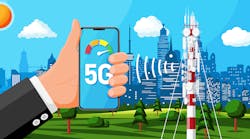Latest from 5G/6G & Fixed Wireless Access/Mobile Evolution
The Impact of 5G On The Cable Industry
Today, the big buzzword in the tech industry is 5G. Verizon and AT&T have already rolled out 5G networks in many cities, and smartphone manufacturers are finally starting to release phones capable of using this technology. The latest installment of the iPhone, the iPhone 12, is the first of Apple’s signature devices to be compatible with 5G.
For most people, this is exciting news. Faster connections capable of doing so much more are on the way. Yet, what does this mean for the cable TV companies? For many years, they have been doubling down on high-speed Internet as their primary revenue source, particularly as people turn away from them for TV and phone service. Some say 5G could bring about the end of cable TV, whereas others think it won’t have much of an impact.
To try and answer this question, we’ve done a deep dive into the issue, and here’s what we found.
The Upsides and Downsides of 5G
At first glance, all of this sounds good: faster connections for more devices. There are other reasons to like 5G, too, which we will discuss in a moment.
There are also some downsides to 5G that are important to remember, especially considering whether or not 5G is a legitimate threat to cable TV and cable Internet.
Here are some of the positive and negative aspects of 5G:
ADVANTAGES
The main advantages of 5G include:
Faster Speeds — Currently, telecommunications companies are advertising speeds of up to or over 1 Gigabit (1,000 Mbps).
Higher Bandwidth — With 4G, if many people are trying to connect to the same tower, the network quickly overloads, and speeds drop dramatically. However, since 5G relies on lower frequency waves, this isn’t the case.
Expanded Technologies — With 5G, we can expect more Artificial Intelligence (AI) and Virtual Reality (VR).
Network Slicing — 5G can be subdivided to create subnets, which can better serve users because they are more exclusive and more directly tailored to their needs.
Cloud — With 5G, cloud capacity increases considerably, which allows us to rely less on our phone’s memory. Whether or not this means we will replace our phones less often remains to be seen.
How Might These Advantages Impact Cable?
These improvements to wireless broadband technology can threaten cable TV companies because they can compete in speed. Up until now, while 4G LTE delivers excellent speeds, its capabilities are nothing compared to what a cable connection can give you. Many companies routinely offer connections of 200 Mbps or more, with Gigabit Internet now also available in most places.
This means that 5G can replace cable Internet in some places, which would be detrimental to the cable TV business model. However, things aren’t as black and white. There are some significant disadvantages to 5G that might help keep cable TV companies and their wired Internet connections.
DISADVANTAGES
The main disadvantages of 5G are:
Short Broadcast Distance — One reason 5G can deliver such high speeds is its lower frequency waves. The downside to this is that these waves cannot travel as far as the waves currently used for 4G. Therefore, to connect to a 5G tower, you need to be relatively close to it. This reduces the number of devices that can be connected to a 5G tower at once, even though 5G can handle more connections.
Concentrated Coverage — Because of the shorter waves and the need to be close to a tower to connect, 5G is an option only, at least currently, for urban markets. This is because, in cities, there are more people living close to a tower, which allows telecommunications companies to sell more subscriptions and more easily recoup the cost of building and maintaining the tower. In rural areas, where users are more spread out, 5G doesn’t make much sense. This means rural users means they may get left behind.
Building Penetration — Another issue with using these lower frequency waves is that they are more likely to be obstructed by buildings, trees, and other large objects. This means that to get a solid 5G connection and enjoy the high speeds it promises, you need to be in line with the tower, something that is not always possible.
Device Compatibility and Battery Drain — The vast majority of smartphone devices on the market today are still equipped only for 4G. 5G is also a huge battery drain, but this will likely improve as 5G devices become more common. Until then, it’s a significant limitation of the technology.
Infrastructure Costs — While 5G is a wireless network, this is only the case for users. It still depends on wires connected to the towers, which then broadcast the signal to wireless devices. Because of the increased capacity of 5G, the current infrastructure does not scale unless it’s fiber. So, telecommunication companies must lay fiber optic cables. Some have already started doing this, but many have not, and installing this infrastructure is very expensive and time-consuming.
How Might These Disadvantages Affect Cable?
As you can see, while 5G is an exciting technology, there are quite a few downsides that must be overcome if it is to become the dominant form of wireless broadband service.
For cable companies, this is good news. The infrastructure for cable TV is already well-established across the entire country, which allows the cable companies to deliver service to people living in rural and remote areas.
Due to using lower frequency waves, cable Internet does not suffer from the same limitations that 5G does. This may continue to make it a more viable option, even for those living in urban areas where 5G is more readily accessible.
Of course, 5G is still new. The telecommunications companies are aware of its limitations, meaning they are likely to try and implement solutions to make it more viable, threatening cable. In the meantime, these specific limitations of 5G make it so that cable will likely remain a viable option for the foreseeable future.
The Current State of the Cable TV Industry
Based on what we know about 5G and its advantages and disadvantages, it doesn’t seem like 5G poses a significant threat to cable companies. However, to truly understand if this is the case, we should look at the current cable TV industry.
The first thing we need to look at is the business model that cable TV companies use. For decades, they relied on 3 services: 1.) home phone, 2.) television, and 3.) Internet.
As you know, home phone service (landlines) is all but dead. Few people sign up for these unless included in bundles with other services that make them basically free. So, this is no longer a genuine source of revenue for cable companies.
Their next revenue stream is television. While still going strong, the reality is that cable companies are hemorrhaging TV customers. All of this means that cable TV companies must rely heavily on their broadband Internet service for revenue. Up until now, this has been a very viable strategy. People still need Internet service, whether they have cable TV or not, especially if they’ve decided to cut the cord and rely solely on streaming. The result has been continuously rising profits and stock prices.
To give you a little better idea of what’s going on in the cable TV industry, here are some stats:
- The 2 largest cable companies, Comcast and Charter, are trading at record high prices. Charter stock prices are up more than 150% in the past 5 years. (Sources 1, 2)
- In 2020, Charter added more than 2.1 million home Internet customers, up from 1.3 million the year before. (Source 3)
- Year-over-year growth for Comcast’s Internet service is above 5%, the highest rate in more than 6 years. (Source 4)
- In 2020 alone, more than 6 million people cut the cord, choosing to drop cable TV services in favor of streaming-only options. (Source 5)
- In total, around 27% of US households have decided to cut the cord. (Source 6)
- Less than 40% of US households currently have a landline, down from more than 90% in 2004. (Source 7)
These numbers more or less confirm what we already suspected: cable companies are rapidly losing TV and phone customers, but they have been making up these losses by adding more and more high-speed Internet customers.
Therefore, while cable companies may no longer look and act like cable companies of the past, they still exist. Generally speaking, they are thriving despite dramatic changes to their business model.
Because of the limitations of 5G, it seems like they might be safe if they continue along this path. Unless, of course, something comes along to disrupt this strategy.
How 5G Might Upset the Cable Industry?
The only way in which 5G might pose a threat to cable companies is if the companies that offer 5G, mainly the big mobile carriers (Verizon, AT&T, and T-Mobile), offer a home Internet service using 5G networks that can compete with cable Internet in terms of price and effectiveness.
As it turns out, this is precisely what they are planning to do. At the moment, cable TV executives don’t seem too concerned, but we’re going to detail these proposed plans for you so that you can see for yourself if their confidence is wise or not.
For 5G to pose a significant threat to cable companies, wireless companies need to offer a competitive product. They hope to do this by bringing 5G networks into people’s homes, which would provide users with more options for network providers and lower prices.
Verizon has already started doing this in select markets. It can offer home Internet connections between 300 and 800 Mbps for just $50 per month, which is considerably lower than what most cable companies are currently doing.
Such a plan poses a serious threat to cable companies, for it offers users better Internet at lower prices. However, for this to work, Verizon and AT&T have to rely on their existing fiber optic networks, something that dramatically limits their ability to reach a significant number of users.
The reason for this is that this is the infrastructure that does not currently exist. Yes, fiber optic Internet is available in some areas, but only really in large cities. Laying these cables is extremely expensive and time-consuming. Verizon and AT&T are massive companies capable of borrowing lots of money to implement this plan, but the question remains if they want to do this.
They have set a goal of getting this service to most of the US within 10 years, though many experts doubt if this is realistic.
So, while this product is a dire threat to cable, it’s unlikely to become widely available enough in the coming years to cut into cable companies’ profits and market share significantly.
The T-Mobile Plan
Over the past few years, T-Mobile has been working to acquire Sprint, the third-largest wireless carrier in the US. Part of the reason T-Mobile wanted to do this was to take advantage of Sprint’s existing infrastructure to offer consumers a completely wireless home Internet connection.
Currently, it can do this, though it has altered the 5G technology slightly, using medium-length waves to send out its signals so that they can travel further and reach more people. This lowers speeds slightly, but T-Mobile can still offer in-home wireless broadband services of 100 Mbps, even in rural areas with little infrastructure.
InvisiLight® Solution for Deploying Fiber
April 2, 2022Go to Market Faster. Speed up Network Deployment
April 2, 2022Episode 10: Fiber Optic Closure Specs Explained…
April 1, 2022Food for Thought from Our 2022 ICT Visionaries
April 1, 2022The difference between T-Mobile’s approach and Verizon and AT&T is that it’s relying on and leveraging existing technology to bring high-speed wireless Internet to people’s homes. They do not have to install new infrastructure, meaning they can offer the service starting now, not years in the future.
However, the main drawback to this approach is that bandwidth is limited. This is the consequence of using a wireless-only network. It works in some cases, but when installed in a home where dozens of devices are connected, and people are streaming movies and video calling, the connection degrades.
Therefore, while this plan promises to bring high-speed Internet to more people, the connection quality is unlikely to match that of cable Internet, which means it is less viable of an alternative and not a serious threat to cable companies.
The Verdict: Is 5G a Threat to Cable TV?
At the moment, 5G does not seem to pose a tremendous threat to cable TV companies. While 5G promises higher speeds and more bandwidth for mobile devices, bringing it into people’s homes is difficult, especially considering the limitations of 5G, mainly the need to be close to and directly aligned with the 5G towers.
However, in the long-term, if mobile carriers such as Verizon and AT&T do succeed in amplifying their networks to provide 5G connections to more homes, particularly outside of cities, then cable companies may indeed be in trouble. This is unlikely to be a big concern for at least another decade.
The “10G” Pledge
Cable companies are actively taking steps to improve their service and remain competitive in this market. More specifically, the entire industry has created and agreed to the “10G Pledge.” Here, the “G” does not refer to generation but rather to gigabit; the goal is to offer wired Internet connections of up to 10GB, which is 10 times faster than what is currently offered.
At the moment, such capacity is not necessary for most people. Yet the COVID-19 pandemic meant the world realized how many more things could happen online (school, work, doctors’ appointments, etc.), so increased speeds may be necessary.
If this upgrade does occur, then cable Internet will once again be vastly superior to anything being offered by the mobile carriers. The threat 5G poses will be all but gone. In the end, while 5G does pose a potential threat to cable TV companies, the actual danger is currently very low.
However, as we know, things in this industry can change on a dime. Innovations are emerging all the time, flipping things upside down seemingly overnight. In the meantime, despite losing lots of television and phone customers, cable companies can rest easy knowing their Internet business is not in any immediate danger.
Sources, References, and Notes
This article is adapted from Is 5G A Threat To Cable?, found at https://www.cablecompare.com/blog/is-5g-a-threat-to-cable-tv.
[1], https://www.cnbc.com/quotes/CMCSA
[2], https://www.cnbc.com/quotes/CHTR
https://www.fiercevideo.com/cable/charter-loses-video-subs-q4-but-still-ends-up-ahead-2020
[3], https://www.fiercevideo.com/cable/charter-loses-video-subs-q4-but-still-ends-up-ahead-2020
[7] https://www.statista.com/chart/2072/landline-phones-in-the-united-states/
https://www.cox.com/presentation/upgrade/browser-update-resi.html
https://www.ncta.com/media/media-room/introducing-10g
For more information, visit CableCompare.com and https://www.cablecompare.com/blog.










